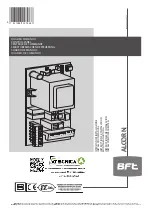
INSTALLATION MANUAL
time by a few seconds with respect to the leaf closing time.
DELAY M2
Sets the delay time on closing of motor 2 (M2) (adjustable from 1 to 30 sec.)
8) INTEGRATED RECEIVER TECHNICAL SPECIFICATION
Receiver output channels:
- output channel 1, if activated, controls a START command.
- output channel 2, if activated, controls the excitation of the 2nd radio channel
relay for 1s.
Transmitter versions which can be used:
all Rolling Code transmitters compatible with
.
ANTENNA INSTALLATION
Use an antenna tuned to 433MHz.
For Antenna-Receiver connection, use RG8 coaxial cable.
The presence of metallic masses next to the antenna can interfere with radio
reception. In case of insufficient transmitter range, move the antenna to a more
suitable position.
9) PROGRAMMING
Transmitter storage can be carried out in manual mode, or by means of the
universal palmtop programmer which allows you to create installations in the
“collective receivers” mode, as well as manage the complete installation database
using the EEdbase software.
10) MANUAL PROGRAMMING
In the case of standard installations where no advanced functions are required,
it is possible to proceed to manual storage of the transmitters
1) If you wish the transmitter T key to be memorised as Start, press thSW1 button on
the control unit, otherwise if you wish the transmitter key to be memorise as second
radio channel, press the SW2 button on the control unit.
2) When the OP LED blinks, press the transmitter P1 hidden key, and the OP LED
will stay on permanently.
3) Press the key to be memorised on the transmitter, LED OP will start blinking
again.
4) To memorise another transmitter, repeat steps 2) and 3).
5) To exit the storage mode, wait until the LED is switched off completely.
IMPORTANT NOTE: ATTACH THE ADHESIVE KEY LABEL TO THE FIRST MEMO-
RISED TRANSMITTER (MASTER).
In the case of manual programming, the first transmitter assigns the key code
to the receiver; this code is necessary in order to carry out subsequent cloning
of the radio transmitters.
10.1) CONTROL UNIT MEMORY CANCELLATION
In order to cancel the control unit memory completely, simultaneously press for
10 seconds the SW1 and SW2 buttons on the control unit (OP LED blinking).
Correct memory cancellation will be indicated by the OP LED staying on perma-
nently. To exit the storage mode, wait until the LED is switched off completely.
11) RECEIVER CONFIGURATION
The on-board receiver combines characteristics of utmost safety in copying varia-
ble code (rolling code) coding with the convenience of carrying out transmitter
“cloning” operations thanks to an exclusive system.
Cloning a transmitter means creating a transmitter which can be automatically
included within the list of the transmitters memorised in the receiver, either as
an addition or as a replacement of a particular transmitter.
Cloning by replacement is used to create a new transmitter which takes the place
of the one previously memorised in the receiver; in this way a specific transmitter
can be removed from the memory and will no longer be usable.
Therefore it will be possible to remotely program a large number of additional
transmitters or, for example, replacement transmitters for those which have been
lost, without making changes directly to the receiver.
When coding safety is not a decisive factor, the on-board receiver allows you to
carry out fixed-code additional cloning which, although abandoning the variable
code, provides a high number of coding combinations, therefore keeping it possible
to “copy” any transmitter which has already been programmed.
12) RADIO-TRANSMITTER CLONING (Fig.7)
Rolling-code cloning / Fixed-code cloning
Make reference to the universal palmtop programmer Instructions and the CLONIX
Programming guide.
12.1) ADVANCED PROGRAMMING: COLLECTIVE RECEIVERS
Make reference to the universal palmtop programmer Instructions and the CLONIX
Programming guide.
13) ACCESSORIES
SPL (fig.4). Pre-heating optional board. Recommended for temperatures below
-10°C. (In the case of hydraulic motors).
ME (fig.5).
Optional board used to connect a 12V~ electric lock.
SS (Fig.6/6A) Optional board for gate-open warning light.
WARNINg: only works if electrical limit switches are used.
With the limit switches connected (configuration DSW 9 OFF) use the diagram
in figure 6.
With the OPEN - CLOSE/PEDESTRIAN buttons (configuration DSW 9 ON) use
the diagram in figure 6A.
EBP (fig.2). The EBP electric lock with continuous service can be connected
directly to terminals 1 and 4.
10 -
ALCOR N
D811509_05
Содержание ALCOR N
Страница 23: ......










































